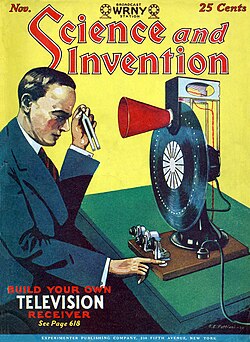
Back Uitvinding Afrikaans Invento AN आविष्कार ANP اختراع Arabic مخترع ARZ Inventu AST आविष्कार AWA İxtira Azerbaijani ایختیراع AZB Вынаходства Byelorussian

An invention is a unique or novel device, method, composition, idea or process. An invention may be an improvement upon a machine, product, or process for increasing efficiency or lowering cost. It may also be an entirely new concept. If an idea is unique enough either as a stand-alone invention or as a significant improvement over the work of others, it can be patented. A patent, if granted, gives the inventor a proprietary interest in the patent over a specific period of time, which can be licensed for financial gain.
An inventor creates or discovers an invention. The word inventor comes from the Latin verb invenire, invent-, to find.[1][2] Although inventing is closely associated with science and engineering, inventors are not necessarily engineers or scientists.[3] Due to advances in artificial intelligence, the term "inventor" no longer exclusively applies to an occupation (see human computers).[4]
Some inventions can be patented. The system of patents was established to encourage inventors by granting limited-term, limited monopoly on inventions determined to be sufficiently novel, non-obvious, and useful or has industrial applicability. A patent is jurisdictional, meaning that a patent only provides rights to the patent owner within the jurisdiction (Country or Countries) in which the patent was obtained. A patent provides the patent owner (who may or may not be an inventor) the right to exclude others from making, using, offering for sale, or selling an invention or importing it into the jurisdiction. The rules and requirements for patenting an invention vary by country and the process of obtaining a patent is often expensive.
Another meaning of invention is cultural invention, which is an innovative set of useful social behaviours adopted by people and passed on to others.[5] The Institute for Social Inventions collected many such ideas in magazines and books.[6] Invention is also an important component of artistic and design creativity. Inventions often extend the boundaries of human knowledge, experience or capability.
- ^ inventor. Dictionary.com. Retrieved 1 October 2017.
- ^ invent Archived 2008-01-15 at the Wayback Machine. Merriam-Webster. Retrieved 1 October 2017.
- ^ *Inventor. Encyclopædia Britannica. Retrieved 1 October 2017.
- ^ Hornby, Gregory S.; Al Globus; Derek S. Linden; Jason D. Lohn (September 2006). "Automated antenna design with evolutionary algorithms" (PDF). Space. American Institute of Aeronautics and Astronautics. Retrieved 2012-02-19.
- ^ Saper, Craig J. (1997). Artificial Mythologies : a Guide to Cultural Invention. University of Minnesota Press. ISBN 978-0-8166-8773-2. OCLC 437188488.
- ^ Albery, Nicholas. (1995). Best ideas : a compendium of social innovations : the latest ideas and award-winning schemes from the Institute for Social Inventions. Institute for Social Inventions. ISBN 0-948826-37-1. OCLC 36969054.
© MMXXIII Rich X Search. We shall prevail. All rights reserved. Rich X Search